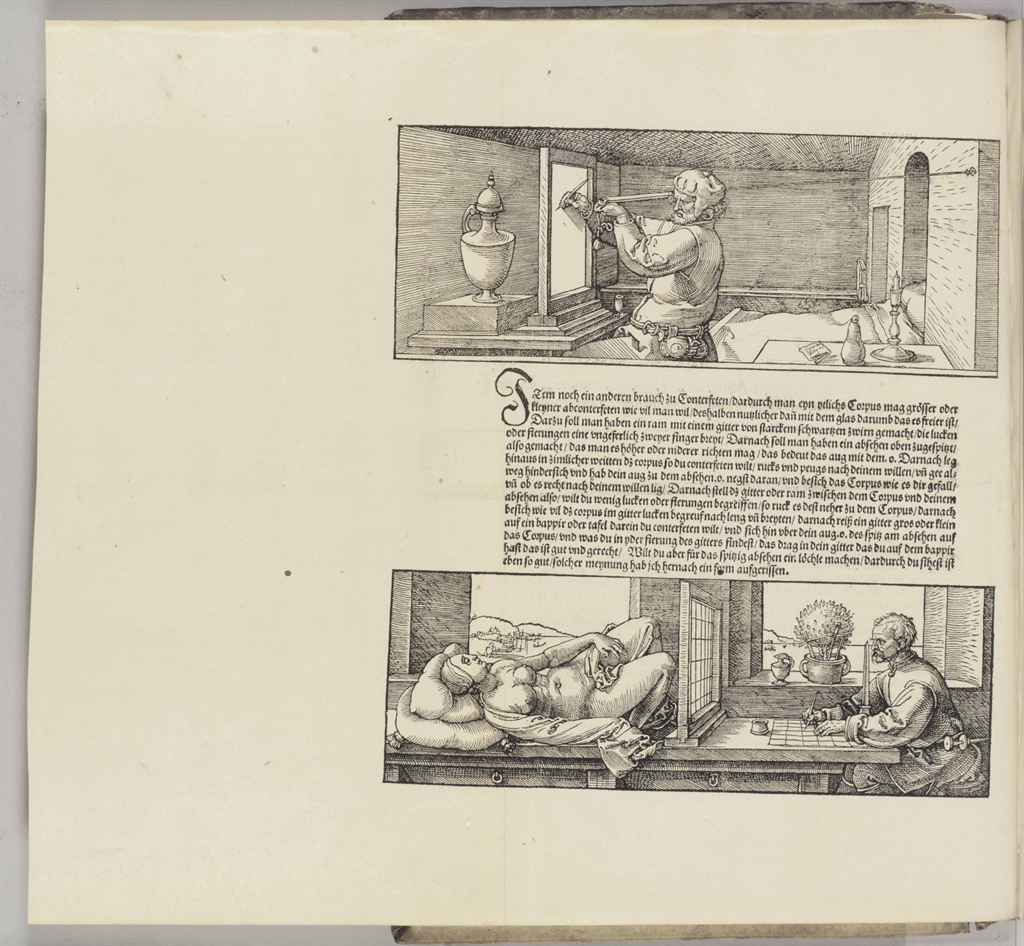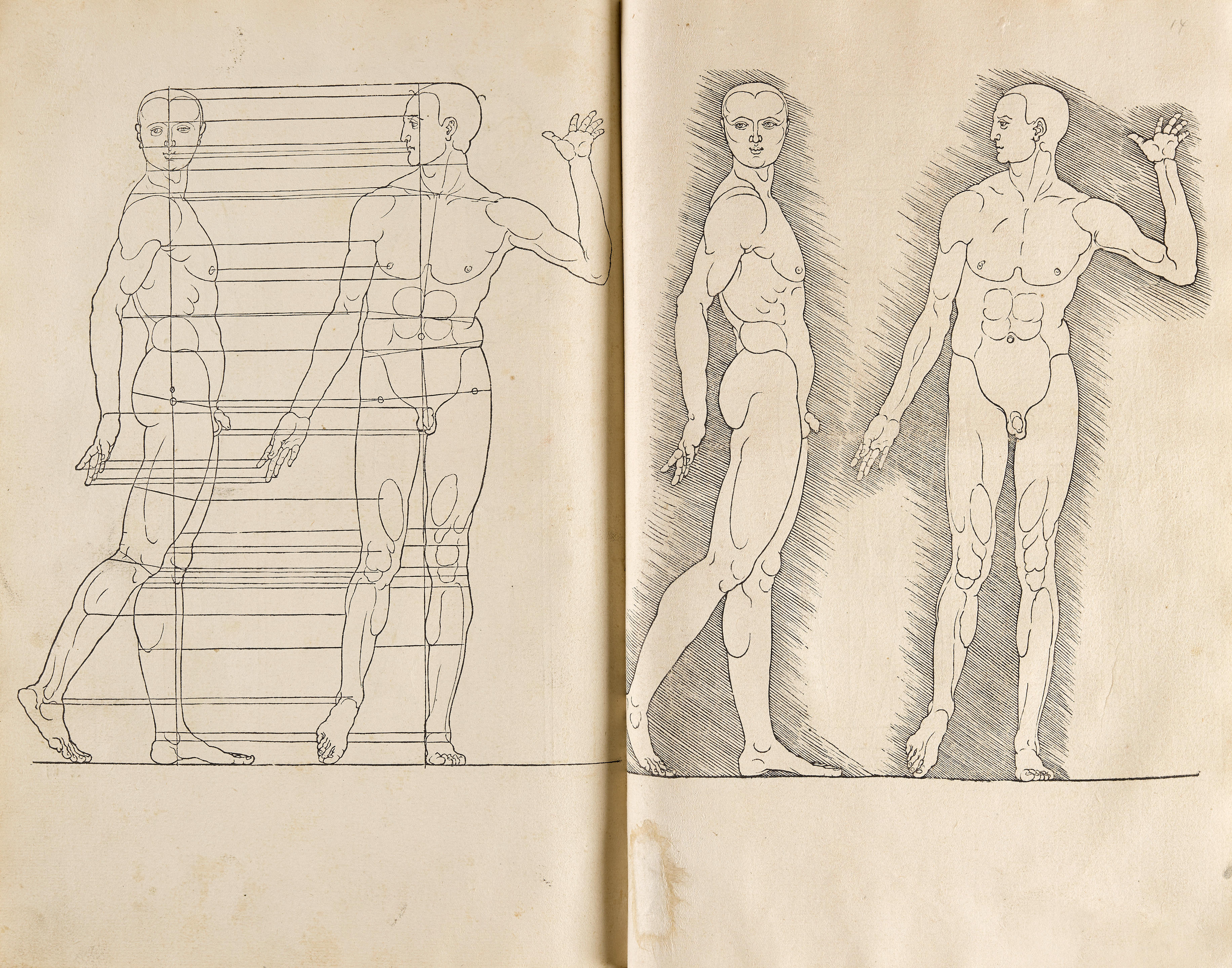DÜRER, Albrecht (1471-1528). Underweysung der messung, mit dem zirckel unn richtscheyt in Linien ebnen unnd gantzen corporen. Nuremberg: [Hieronymus Andreas Formschneider], 1525. – [ Bound with :] Etliche underricht, zu befestigung der Stett, Schlosz, und Flecken. Nuremberg: [Hieronymus Andreas Formschneider], October 1527. -- Hierinn sind begriffen vier bücher von menschlicher Proportion . Edited by Willibald Pirckheimer. Nuremberg: Hieronymus Andreae Formschneider for Dürer's widow, 31 October 1528.
DÜRER, Albrecht (1471-1528). Underweysung der messung, mit dem zirckel unn richtscheyt in Linien ebnen unnd gantzen corporen. Nuremberg: [Hieronymus Andreas Formschneider], 1525. – [ Bound with :] Etliche underricht, zu befestigung der Stett, Schlosz, und Flecken. Nuremberg: [Hieronymus Andreas Formschneider], October 1527. -- Hierinn sind begriffen vier bücher von menschlicher Proportion . Edited by Willibald Pirckheimer. Nuremberg: Hieronymus Andreae Formschneider for Dürer's widow, 31 October 1528. First editions. An important Sammelband containing three treatises Dürer wrote toward the end of his life and which he also designed for the press. These include: a treatise on mensuration which introduced to Northern Europe techniques of perspective and mathematical proportion in drawing, painting, architecture and letter forms, which Dürer learned in Italy; a treatise on fortification; and a work on the proportion of the human body. The last work, issued shortly after Dürer's death, was the first work to discuss the problems of comparative and differential anthropometry. 3 works bound in one, folio (308 x 211 mm) comprising: Underweysung : 90 leaves (with final blank). Numerous woodcuts of geometrical diagrams and architectural renderings, two, on P4v and Q1r, extended with pasted-in folding slips to demonstrate a point in perspective, two figures on C5v and K1r printed on pasted-in cancel slips correcting the original figures; two half-page woodcuts showing artists using Dürer's drafting apparatus for drawing in perspective, the second with Dürer's monogram and dated 1525 (as are 2 of the triumphal column cuts); roman and gothic alphabets. (Some staining, dampstaining to upper margin, P1v and P2r with dark staining affecting a few lines.) -- Etliche underricht : title with large woodcut arms of Ferdinand I, 20 woodcut illustrations or diagrams of fortifications some with folding extensions, G1 errata-leaf; woodcut fraktur initials (A few holes to folding plates affecting text, some soft creases some browning and staining). – Proportion : Dürer's large woodcut monogram on title, approximately 136 full-length proportional woodcuts of human figures, many two to a page, and numerous smaller, geometrical or proportional woodcut diagrams, some of individual body parts (heads, arms, hands or feet), fraktur initials, flourished woodcut tail-piece ornaments, 5 fold-out sheets printed on both sides, colophon on verso of Z3, Gothic type, mostly double-column. (Some browning and staining.) Contemporary blind-tooled pigskin over beveled, two brass clasps and catches (one catch missing, lower board with clean crack at center, some rubbing and staining). Provenance : “PS” (early woodcut bookplate); Joseph and Josephine W. Drexler (bookplate)’ Lucy Wharton Drexler (bookplate). Adams D-1057. Unlike his Italian contemporary, Leonardo da Vinci who published nothing, Dürer lived and worked in the world of printing and engraving. The son of a goldsmith, Dürer's godfather was Anton Koberger who left goldsmithing to become the leading printer and publisher in Nuremberg. At the age of 15 Dürer was apprenticed to the leading artist in Nuremberg, Michael Wolgemut whose workshop produced a large quantity of woodcuts. Throughout his career Dürer embraced the latest and best reproduction techniques, and may have derived more income from the sale of engravings and woodcuts than from painting. The Sammelband includes: Underweysung der messung, mit dem zirckel unn richtscheyt in Linien ebnen unnd gantzen corporen. FIRST EDITION of one of the earliest mathematical works published in German. Although written after his treatise on human proportion, the Underweysung der messung was the first of Dürer’s three theoretical works on art to be published. Conceived as a practical guide to the rules of geometry and principles of perspective for artists, architects, sculptors, stonemasons and other craftsmen, the work introduced to northern Europe a system of p
DÜRER, Albrecht (1471-1528). Underweysung der messung, mit dem zirckel unn richtscheyt in Linien ebnen unnd gantzen corporen. Nuremberg: [Hieronymus Andreas Formschneider], 1525. – [ Bound with :] Etliche underricht, zu befestigung der Stett, Schlosz, und Flecken. Nuremberg: [Hieronymus Andreas Formschneider], October 1527. -- Hierinn sind begriffen vier bücher von menschlicher Proportion . Edited by Willibald Pirckheimer. Nuremberg: Hieronymus Andreae Formschneider for Dürer's widow, 31 October 1528.
DÜRER, Albrecht (1471-1528). Underweysung der messung, mit dem zirckel unn richtscheyt in Linien ebnen unnd gantzen corporen. Nuremberg: [Hieronymus Andreas Formschneider], 1525. – [ Bound with :] Etliche underricht, zu befestigung der Stett, Schlosz, und Flecken. Nuremberg: [Hieronymus Andreas Formschneider], October 1527. -- Hierinn sind begriffen vier bücher von menschlicher Proportion . Edited by Willibald Pirckheimer. Nuremberg: Hieronymus Andreae Formschneider for Dürer's widow, 31 October 1528. First editions. An important Sammelband containing three treatises Dürer wrote toward the end of his life and which he also designed for the press. These include: a treatise on mensuration which introduced to Northern Europe techniques of perspective and mathematical proportion in drawing, painting, architecture and letter forms, which Dürer learned in Italy; a treatise on fortification; and a work on the proportion of the human body. The last work, issued shortly after Dürer's death, was the first work to discuss the problems of comparative and differential anthropometry. 3 works bound in one, folio (308 x 211 mm) comprising: Underweysung : 90 leaves (with final blank). Numerous woodcuts of geometrical diagrams and architectural renderings, two, on P4v and Q1r, extended with pasted-in folding slips to demonstrate a point in perspective, two figures on C5v and K1r printed on pasted-in cancel slips correcting the original figures; two half-page woodcuts showing artists using Dürer's drafting apparatus for drawing in perspective, the second with Dürer's monogram and dated 1525 (as are 2 of the triumphal column cuts); roman and gothic alphabets. (Some staining, dampstaining to upper margin, P1v and P2r with dark staining affecting a few lines.) -- Etliche underricht : title with large woodcut arms of Ferdinand I, 20 woodcut illustrations or diagrams of fortifications some with folding extensions, G1 errata-leaf; woodcut fraktur initials (A few holes to folding plates affecting text, some soft creases some browning and staining). – Proportion : Dürer's large woodcut monogram on title, approximately 136 full-length proportional woodcuts of human figures, many two to a page, and numerous smaller, geometrical or proportional woodcut diagrams, some of individual body parts (heads, arms, hands or feet), fraktur initials, flourished woodcut tail-piece ornaments, 5 fold-out sheets printed on both sides, colophon on verso of Z3, Gothic type, mostly double-column. (Some browning and staining.) Contemporary blind-tooled pigskin over beveled, two brass clasps and catches (one catch missing, lower board with clean crack at center, some rubbing and staining). Provenance : “PS” (early woodcut bookplate); Joseph and Josephine W. Drexler (bookplate)’ Lucy Wharton Drexler (bookplate). Adams D-1057. Unlike his Italian contemporary, Leonardo da Vinci who published nothing, Dürer lived and worked in the world of printing and engraving. The son of a goldsmith, Dürer's godfather was Anton Koberger who left goldsmithing to become the leading printer and publisher in Nuremberg. At the age of 15 Dürer was apprenticed to the leading artist in Nuremberg, Michael Wolgemut whose workshop produced a large quantity of woodcuts. Throughout his career Dürer embraced the latest and best reproduction techniques, and may have derived more income from the sale of engravings and woodcuts than from painting. The Sammelband includes: Underweysung der messung, mit dem zirckel unn richtscheyt in Linien ebnen unnd gantzen corporen. FIRST EDITION of one of the earliest mathematical works published in German. Although written after his treatise on human proportion, the Underweysung der messung was the first of Dürer’s three theoretical works on art to be published. Conceived as a practical guide to the rules of geometry and principles of perspective for artists, architects, sculptors, stonemasons and other craftsmen, the work introduced to northern Europe a system of p







.jpg)





Try LotSearch and its premium features for 7 days - without any costs!
Be notified automatically about new items in upcoming auctions.
Create an alert